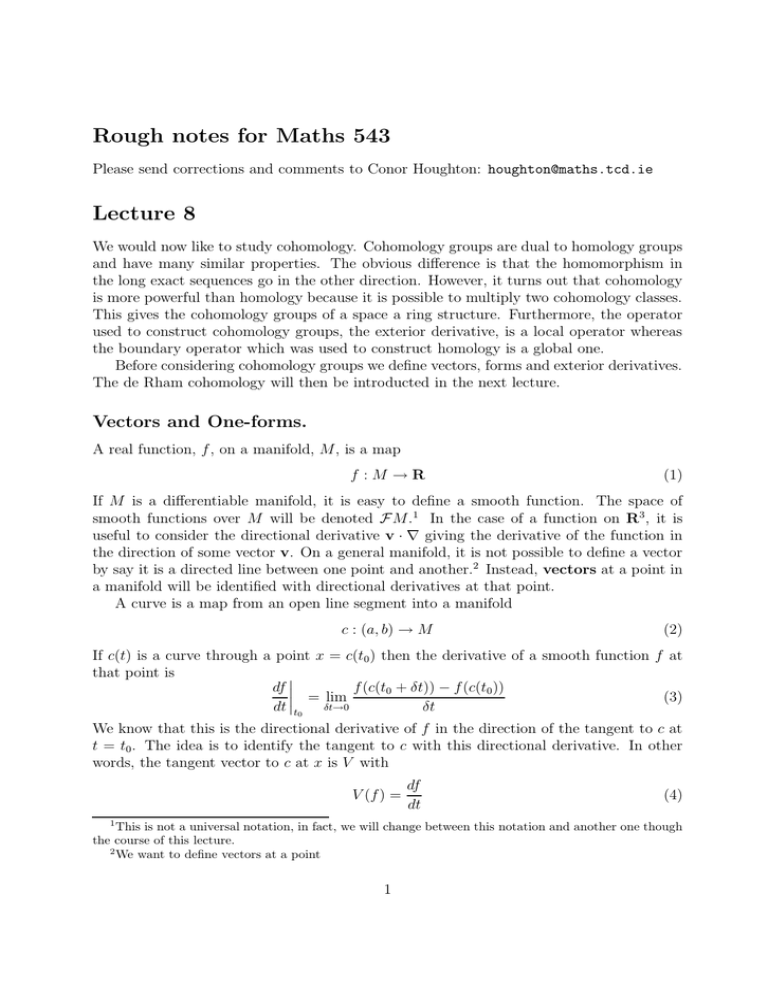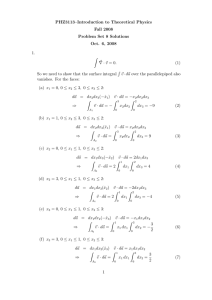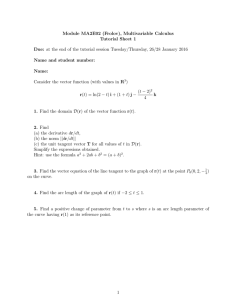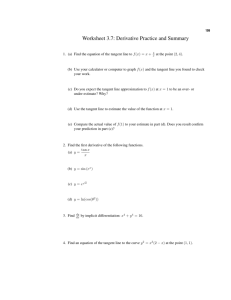Rough notes for Maths 543 Lecture 8
advertisement

Rough notes for Maths 543
Please send corrections and comments to Conor Houghton: houghton@maths.tcd.ie
Lecture 8
We would now like to study cohomology. Cohomology groups are dual to homology groups
and have many similar properties. The obvious difference is that the homomorphism in
the long exact sequences go in the other direction. However, it turns out that cohomology
is more powerful than homology because it is possible to multiply two cohomology classes.
This gives the cohomology groups of a space a ring structure. Furthermore, the operator
used to construct cohomology groups, the exterior derivative, is a local operator whereas
the boundary operator which was used to construct homology is a global one.
Before considering cohomology groups we define vectors, forms and exterior derivatives.
The de Rham cohomology will then be introducted in the next lecture.
Vectors and One-forms.
A real function, f , on a manifold, M , is a map
f :M →R
(1)
If M is a differentiable manifold, it is easy to define a smooth function. The space of
smooth functions over M will be denoted F M .1 In the case of a function on R3 , it is
useful to consider the directional derivative v · ∇ giving the derivative of the function in
the direction of some vector v. On a general manifold, it is not possible to define a vector
by say it is a directed line between one point and another.2 Instead, vectors at a point in
a manifold will be identified with directional derivatives at that point.
A curve is a map from an open line segment into a manifold
c : (a, b) → M
(2)
If c(t) is a curve through a point x = c(t0 ) then the derivative of a smooth function f at
that point is
df f (c(t0 + δt)) − f (c(t0 ))
(3)
= lim
dt t0 δt→0
δt
We know that this is the directional derivative of f in the direction of the tangent to c at
t = t0 . The idea is to identify the tangent to c with this directional derivative. In other
words, the tangent vector to c at x is V with
V (f ) =
df
dt
(4)
1
This is not a universal notation, in fact, we will change between this notation and another one though
the course of this lecture.
2
We want to define vectors at a point
1
If (x1 , x2 , . . . , xn ) are coordinates at x then
V (f ) =
df
dxi ∂f
=
dt
dt ∂xi
(5)
where we sum on i and where the curve is given by (x1 (t), x2 (t), . . . , xn (t)) in the coordinate
neighbourhood of of x. Thus, we can write
V = Vi
∂
∂xi
(6)
where Vi = dxi /dt.
In other words, a basis for the tangent vectors at the point x is given by3
(
∂
∂
∂
,
,...,
)
∂x1 ∂x2
∂xn
(7)
Now, if we change coordinates from (x1 , x2 , . . . , xn ) to (y1 , y2 , . . . , yn ) the components of
the vector change
∂
∂yj ∂
V = Vi
= Vi
(8)
∂xi
∂xi ∂yj
as the components of a contravariant vector. This shows that our definition of a vector
coincides with the component bases definition sometimes used on Rn .4
The vector space of tangent vectors at a point x is often write Tx M and called the
tangent space of M at p. A tangent vector field is a smooth assignation of a tangent
vector at each point in a manifold.5 The space of tangent vector fields is often denoted
X M.
Since Tx M is a vector space, we can define its dual space Tx∗ M with ω ∈ Tx∗ M a map
ω : Tx M → R.
(9)
Of course, since Tx M is an n-dimensional vector space, so is Tx∗ M . However, the tangent
space isn’t just an assignation of a vector space to each point in space, we know how a
3
Of course, this makes a lot of sense because the coordinate map maps from an open neighbourhood
of x to a subspace of Rn and we can define a curve by taking the inverse image of straight line. By taking
the straight lines parallel to the Cartesian axes we get the basis vectors.
∂
4
, ∂ , . . . , ∂x∂ n ) is sometimes called a coordinate basis because it is derived from a
The basis ( ∂x
1 ∂x2
∂
coordinate system. Another basis Aij ∂x
with A ∈ GLn R may not arise as a set of tangents to coordinate
j
curves.
5
It should be intuitively clear what this is supposed to mean. Roughly speaking, near a point a manifold
looks like a subset U of Rn . Since the tangent space also looks like Rn the tangent vector field is a map
from U to Rn and this map is required to be smooth. In fact, later on we will see that a tangent vector
field is a smooth section of the tangent bundle T M . One convenient way of defining a smooth vector field
without first defining the tangent bundle is to require that the function V (f ) is smooth for any smooth
f ∈ FM
2
vector acts on a function. In fact, if f ∈ F X and V ∈ Tx M then V (f ) ∈ R. Thus, a
function defines an element of Tx∗ M which we call df :
df : V 7→ V (f )
(10)
or, put another way, df (V ) = V (f ).
The thing is, f need not be globally define. On a coordinate patch U there is a smooth
map φ : U → Rn . Restricting to one of the n coordinates gives a locally defined function
and hence, a locally defined element of Tm∗ M . In fact, not only is (dx1 , dx2 , . . . , dxn ) a
coordinate basis for Tm∗ M , but, since
∂
∂xi
dxi
=
= δij
(11)
∂xj
∂xj
it is the dual basis under the natural inner product
Tm∗ M × Tm M → R
(ω, V ) 7→ ω(V ).
(12)
The notation is partly justified by noting that the coordinate independence of the contraction ω(V ) implies6
∂xi
dyj .
(13)
ω = ωi dxi = ωi
∂yj
An element of the cotangent space Tx∗ M is sometimes called a cotangent. However,
it is more common to refer to them as one-forms. We will see why in the next section.
We will define what are called p-forms and it will turn out that a p-form with p = 1 is a
cotangent. Before going on to p-forms, we will look at an important map between different
cotangent spaces: the pullback.
A map between two manifolds induces a map between their tangent bundles. For the
moment we are restricting our attention to the tangent space at a point, so we note that,
given a smooth map f : M m → N n there is a map
f∗ : Tm M → Tf (m) N
(14)
(f∗ V )(g) = V (g ◦ f )
(15)
defined by
In other words, if g is a function on N then g ◦ f is a function on M and so we can evaluate
V (g ◦ f ). If m has coordinates (x1 , x2 , . . . , xn ) this means
V = Vi
∂
∂xi
(16)
6
Of course, there is no real need to justify the notation, after a while and especially after we have
considered integration, it will seem very natural. In fact, dxi is a modern formulation of the classical idea
of a small increment in xi .
3
and if f (x1 , x2 , . . . , xm ) = (y1 , y2 , . . . , yn ) then
∂
∂yi
(17)
∂yj
.
∂xi
(18)
f∗ V = (f∗ V )i
Taking g = yj
(f∗ V )j = Vi
p-forms.
We will start this section by defining a tensor. We’ll then go on to discuss p-forms: p-forms
are an important class of tensors.
A tensor, T , of type (q, r) is a multilinear map which takes q cotangents and r vectors
and maps them to the real numbers. At a point x
T : (⊗q Tx∗ M ) ⊗ (⊗r Tx M ) → R
(19)
Thus, if ω1 , . . . ωq are q cotangents and V1 , . . . , Vr are r vectors
T : (ω1 , . . . , ωq , V1 , . . . , Vr ) 7→ T (ω1 , . . . , ωq , V1 , . . . , Vr ) ∈ R
(20)
In this notation, a cotangent is a type (0,1) tensor because it maps a vector to R. In the
same way a vector is a type (1,0) tensor.7
Furthermore, we can write a tensor in terms of components
T = Ti...jk...l
∂
∂
⊗ ...⊗
⊗ dxk ⊗ . . . ⊗ dxl
∂xi
∂xj
(21)
and, under a change of variables the components of a type (q, r) tensor transforms as you
might expect. Finally, a tensor field is defined in the obvious way.
A p-form is a totally antisymmetric tensor of type (0, p). Thus, if ω is a p-form at x
ω : ⊗ p Tx M → R
(V1 , V2 , . . . , Vp ) 7→ ω(V1 , V2 , . . . , Vp ) ∈ R
such that
ω(Vi , Vj , . . . , Vk ) = sign
i j ... k
1 2 ... p
ω(V1 , V2 , . . . , Vp )
(22)
(23)
7
The notation is very bad here and it isn’t really worth sorting it out since it is usually obvious what
is meant. The problem is we have defined a vector as a differential operator on a function: V : f 7→ V (f ).
We then defined the cotangent, or one-form, as a vector in the dual space, so T ∗ M 3 ω : V 7→ ω(V ) ∈ R.
Furthermore, we noted that a function f defines a one-form, df where df : V 7→ df (V ) = V (f ). However,
the dual of the dual of a finite-dimensional vector space is itself, so V can also be thought of as acting on
the space of cotangents, V : ω 7→ V (ω) = ω(V ). This is precisely the attitudes taken when pointing out
that a vector is a type (1,0) tensor, the problem is you end up with V (df ) = V (f ), the point being that
the action denoted by the brackets is different in each case. Ah well.
4
So, for example, if ω is a two-form and V1 and V2 are both vectors then ω(V1 , V2 ) is a real
number with ω(V1 , V2 ) = −ω(V2 , V1 ).
The space of p-forms at x is commonly called Ωpx M . Since the anti-symmetry holds
trivially for maps with one argument Ω1x M = Tx∗ M . The space of p-form fields is called
Ωp M .
A basis for Ωpx M can be constructed from the basis for Tx∗ M using the totally antisymmetric product of the basis one-forms. This totally antisymmetric product is called the
wedge product. The wedge product of one-forms {dx1 , dx2 , . . . , dxp } is
X
i j ... k
dx1 ∧ dx2 ∧ . . . ∧ dxp =
sign
dx1 ⊗ dx2 ⊗ . . . ⊗ dxp
(24)
1 2 ... p
Sp
where the sum is over all permutations. Thus, for example,
dx1 ∧ dx2 ∧ dx3
= dx1 ⊗ dx2 ⊗ dx3 + dx2 ⊗ dx3 ⊗ dx1 + dx3 ⊗ dx1 ⊗ dx2
−dx1 ⊗ dx3 ⊗ dx2 − dx2 ⊗ dx1 ⊗ dx3 − dx3 ⊗ dx2 ⊗ dx1 .
(25)
Now, if (dx1 , dx2 , . . . , dxn ) is a basis for Tx∗ M then all the p-forms constructed by wedging
together p of these one-forms gives a basis for Ωpx M . Because there is an independent p-form
of this type for every selection of p different one-forms from the set {dx1 , dx2 , . . . , dxn },8
it follows that
n
p
dimΩx M =
(26)
p
For convenience, we define Ω0x M = R.9 Note that Ω0x M = R as well: all n-forms are
proportional to dx1 ∧ dx2 ∧ . . . ∧ dxn .
Anyway, this means that a p-form is given locally as
ω=
1
ωij...k dxi ∧ dxj ∧ . . . ∧ dxk
p!
(27)
The factorial prefactor is included so that the components ωij...k are also the components
of the corresponding tensor as given above. We could get rid of it by only including each
basis vector once
X
ω=
ωij...k dxi ∧ dxj ∧ . . . ∧ dxk .
(28)
i<j<...<k
If (y1 , y2 , . . . , yn ) is another basis the antisymmetry means that
ω=
1
1
∂(xi , xj , . . . , xk )
ωij...k dxi ∧ dxj ∧ . . . ∧ dxk = ωij...k
dyi ∧ dyj ∧ . . . ∧ dyk
p!
p!
∂(yi , yj , . . . , yk )
8
(29)
Obviously dxi ∧dxj ∧. . .∧dxk = 0 is some one-form dxl appears twice. If dxi ∧...∧dxj and dxk ∧. . .∧dxl
contain the same one-forms but in a different order, then they are either equal or one is equal to minus
the other, depending on weather the reordering is even or odd.
9
This means that a function is a zero-form field, that is, FM = Ω0 M .
5
Of course, the definition of the wedge product need not be restricted to basis one forms,
we can define the wedge (or exterior) product of two forms in a basis independent way:
if ζ ∈ Ωqx M and η ∈ Ωrx M then ζ ∧ η ∈ Ωxq+r M is defined by10
1 X
i ...
l
ζ(Vi , . . . , Vj )η(Vk , . . . , Vl ) (30)
sign
(ζ ∧ η)(V1 , V2 , . . . , Vq+r ) =
1 ... q +r
q!r!
Sq+r
The wedge product is associative: (ζ ∧ η) ∧ ξ = ζ ∧ (η ∧ ξ). It has graded commutativity
properties, if ζ ∈ Ωq M and η ∈ Ωr M then ζ ∧ η = (−)qr η ∧ ζ. It follows that ζ ∧ ζ = 0 if
q is odd.
Thus, there is a graded algebra of forms
Ω∗x M = Ω0x M ⊕ Ω1x M ⊕ . . . ⊕ Ωnp M
(31)
with multiplication given by the wedge product.
Notice that a vector V defines a map Ωpx M → Ωp−1
x M by partial evaluation: V :
ω 7→ iV ω where iV ω(V1 , . . . , Vp−1 ) = ω(V, V1 , . . . , Vp−1 ). This map is called the interior
product.
The exterior derivative
The exterior derivative is a differential operator which maps p-forms to (p + 1)-forms. It is
usually defined in terms of its action on components, once we have done that and calculated
some of its properties, we will see that these properties define the action of the exterior
derivative. In other words, the component based definition is actually basis independent.
Given ω ∈ Ωp M , in a coordinate neighbourhood
ω=
1
ωij...k dxi ∧ dxj ∧ . . . ∧ dxk .
p!
(32)
and we define the exterior derivative d : Ωp → Ωp+1 by
dω =
1 ∂ωij...k
dxl ∧ dxi ∧ dxj ∧ . . . ∧ dxk .
p! ∂xl
(33)
Thus, if f ∈ Ω0 M = F M then
df
dxi .
(34)
dxi
We can see from this that the exterior derivative of a function is df , you could think that
this justified the notation used for df , it is better though to think of the exterior derivative
as generalizing the construction of df from f to general p and p + 1 forms.
df =
10
The factorial factors are convenient, but note, this isn’t a universal convention, most people put them
in, some people don’t, lots of people can never quite remember weather they do or not.
6
As another example, consider M = R3 . An element of F R3 is just an ordinary function
in space. Ω1x R3 is three dimensional and so we can identify a one-form ζ ∈ Ω1x R3 with a
3-vector at that point
ζ1
ζ = ζ1 dx1 + ζ2 dx2 + ζ3 dx3 ↔ ζ2
(35)
ζ3
With this identification d acts on functions over space as grad:
df =
∂f
∂f
∂f
dx1 +
dx2 +
dx3
∂x1
∂x2
∂x3
(36)
Furthermore, Ω2x R3 is also three dimensional and we can also identify two-forms with
vectors11
η1
(37)
η = η1 dx2 ∧ dx3 + η2 dx3 ∧ dx1 + η3 dx1 ∧ dx2 ↔ η2
η3
If ζ is a one-form with the components above
∂ζ3
∂ζ2
∂ζ1
∂ζ3
∂ζ2
∂ζ1
dζ =
−
dx2 ∧ dx3 +
−
dx3 ∧ dx1 +
−
dx1 ∧ dx2 (38)
∂x2 ∂x3
∂x3 ∂x1
∂x1 ∂x2
and so it is the curl. Finally, Ω2x R3 is one-dimensional and elements are of the form
f dx1 ∧ dx2 ∧ dx3 . They can be identified with functions in the obvious way. If η is a
two-form with the components given above, then
∂η2
∂η3
∂η1
dη =
+
+
dx1 ∧ dx2 ∧ dx3
(39)
∂x1 ∂x2 ∂x3
and this is div.
Thus, d is defined as a map d : Ωp M → Ωp+1 M but in the case of R3 both the oneform fields and two-form fields can be identified with vector fields and, if this is done, the
exterior derivative gives us the sequence of maps
grad
curl
div
0 −→ Ω0 R3 −→ Ω1 R3 −→ Ω2 R3 −→ Ω3 R3 −→ 0
(40)
This sequence is a complex because curl grad f = 0 and div curl v = 0. In fact, it is
clear from the definition of the exterior derivative that d2 = 0. This is what is used to
define the de Rham cohomology. R3 isn’t such a good example in this context, both
because it has trivial cohomology and because it isn’t compact. It is a good example of
calculating the exterior derivative though and an interesting example because it shows that
the different operators in vector calculus are all just examples of one structure. It might
11
I’m leaving out the half for convenience, thus, in the previous notation η1 = 21 η23 and so on.
7
also be interesting to note that the wedge product on Ω1 R3 coincides with the usual cross
product of vectors.
Our next task is to list the important properties of the exterior derivative and then to
observe, after Spivak, that these actually define a unique operator.
We noted above that the exterior derivative sends a function f to df . It is clearly linear
and it is easy to see that it acts on exterior products as a graded derivation:
d(η ∧ ζ) = dη ∧ ζ + (−)p η ∧ dζ
(41)
where eta is a p-form. Finally, as noted above, since differentiation is symmetric and the
wedge product of one-forms is skew-symmetric
d(dω) = 0.
(42)
If d0 is another linear graded derivation with d02 f = 0 and d0 f = df then d0 ω = dω.
This is proven by induction. By linearity we need only consider ω = f dx1 ∧ . . . ∧ dxp .
Acting with d0 ,
d0 ω = d0 f ∧ dx + f ∧ d0 (dx1 ∧ . . . ∧ dxp ) = df ∧ dx + f ∧ d0 (dx1 ∧ . . . ∧ dxp )
(43)
If we assume that dη = d0 η for ω a (p − 1)-form then
d0 dx = d0 (dx1 ∧ dx2 ∧ . . . ∧ dxp ) = −d0 x1 ∧ d0 (dx2 ∧ . . . ∧ dxp ) = 0
(44)
and so the second term in the expression for d0 ω vanishes and so the equality holds for pforms, giving the induction step, proving the theorem and demonstrating that the definition
we have used is actually coordinate independent.
The exterior derivative is only one of the differential operators we should be considering
on a smooth manifold. Another very common and very important operator is the Lie
derivative. Unfortunately we need to press on and so the next lecture will start with the
de Rham cohomology. This is defined by the complex
d
d
d
. . . −→ Ωp M −→ Ωp+1 M −→ Ωp+2 M −→ . . .
8
(45)







